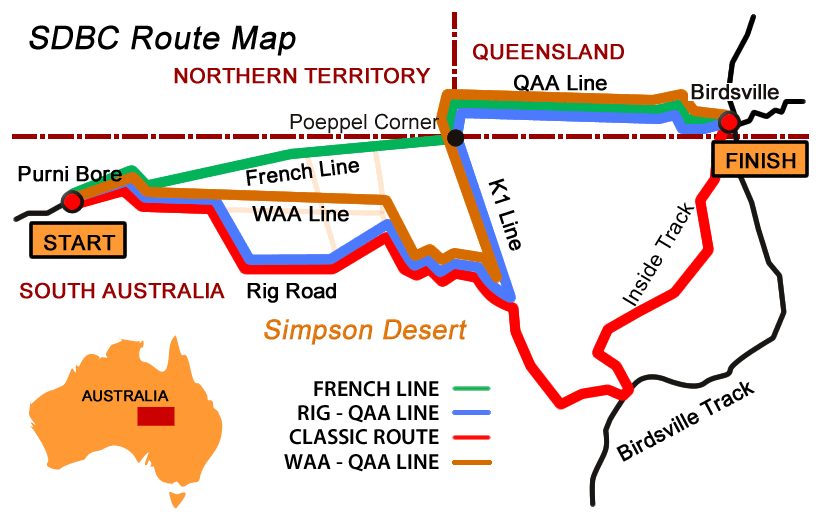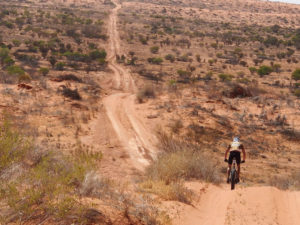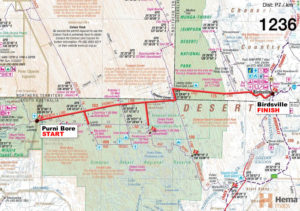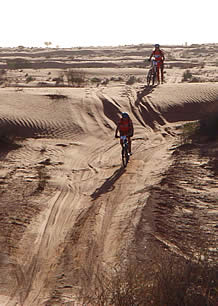The Simpson Desert Bike Challenge crosses the Simpson Desert usually from West to East starting at Purni Bore (Sth Aust) and finishing at Birdsville (Qld). Various new routes have been developed over the years. Each route has its own character as terrain varies from giant sand dunes to flat gibber plains. Each route has a different mix of terrain.
Race Route 2024 – “All The Good Bits”

Route Description
All The Good Bits is the traditional West to East route! The race route starts in Purni Bore and will traverse the Simpson Desert initially heading East along the WAA Line and Rig Road. Day 2, Stage 3 heads East along the Rig Road and North along the Erabena Track to the junction with the WAA Line and finally finishing the day at the junction of Knolls Track.
Day 3 heads North to the French Line – after 35km of undulating gravel tracks, we head East towards Poeppel corner along the notorious French Line. The dunes are big and the swales are short but relief is insight as we near Poeppel corner and the salt pans.
With half the stages complete, we start Stage 6, the 20km night stage. Lights are mandatory so please ensure that you bring a good set of bike lights with you.
Day 4 is a big day but offers an easy start as we head North from Poeppel Corner along the salt pans before turning East onto the QAA Line. The dunes might look like tidal waves but the swales are long and offer plenty of recovery time.
Fat Bikes are built for dune surfing and Stage 9 offers just that as we ride the dune ridge line from Little Red to Big Red and back. It’s a fun stage that often reminds us why we love fat bikes across sand dunes.
Stage 10 heads direct to the finish line – hopefully without a headwind!
Other Race Routes
How the Race is Run
The race consists of nine or ten timed stages over five days and covers around 485 – 570 km depending on the route selected for that year. The morning stage of around 70-80 km gets underway at 5.30-6.00am. There is a break between morning and afternoon stages with the afternoon stage of around 40-50 km.
On Day Five there are one or two stages with the race ending early afternoon and finishing outside the Birdsville Pub in Queensland.
The event has a minimum speed requirement (total elapsed time). Riders must maintain an average of 12 kph to stay ahead of the pursuing sweep vehicle. If caught by the Sweep, riders are transported by vehicle to the end of that stage. Riders will be credited with the distance they have covered and can then restart the next stage as normal.
Water Stops are located approximately every 20km in the morning and at 15km, 30km and 40km in the afternoon. It is mandatory to stop and collect water at every Water Stop.
Riders must be self sufficient during each stage as no support vehicles are permitted on the track while the race is in progress. Support vehicles must travel in either the front convoy ahead of the riders or in the rear convoy behind the Sweep vehicle.
Medical teams patrol the course throughout the race to monitor the physical and mental status of the riders.
Race regulations require each vehicle to have a UHF radio and a high visibility safety flag.
All communications during the race will be on channel UHF 10. This is the frequency used throughout the Simpson Desert. It is essential to able to communicate with other vehicles in the convoy at all times.
The race routes traverse tracks that were constructed for oil exploration in the 1950s. In wet conditions track closures are common and the race may need to be diverted.
Route Descriptions:
The French Line
French Line/QAA Line
This route heads straight across the desert following the French Line and then joining up with the QAA line. It’s the shortest route across the desert between Purni Bore and Birdsville but not the easiest.
The route runs at right angles to the parallel dune system requiring riders to scale dune after dune. The track dips and twists and the surface is often deep, loose sand with some hard pack fast sections.
The dunes get bigger as the race progresses culminating with Big Red as the last and biggest dune in the desert at around 40 metres tall!
The final criterion along the sand dune ridges between Big Red and Little Red provides a spectacular view of riders riding sand ridges and cresting dunes with panoramic views from 30 metres up.
Due to the deep sand the French Line is recommended for ‘Fat Bikes’ only.
The race route has many characteristics and with stage names like ‘Racing Snake’, ‘The Belly of the Beast’, ‘Gnarly Knolls’ and ‘Birdsville Bar Blast’ you wont want to miss any of it.
Click Here for a full description of the French Line route
The WAA Line
WAA Line / QAA Line
This route starts in Purni Bore before heading South to join the WAA Line. You can think of the WAA as a miniature version of the French Line, though less travelled. Its perfect terrain for a fat bike and low tyre pressure.
At the junction of Knolls track, we have options to head North to the junction of the French Line or South to the Rig Road.
We continue East along the QAA line, which is ridden in a single day, and attempt to get all riders up Little Red in time for sunset.
A favourite of this route, and the French Line route, is the morning stage on Day 5. The riders get to dune ride from Little Red to Big Red. It’s a fun stage on a fat bike as your surf down a down and churn back up the other side.
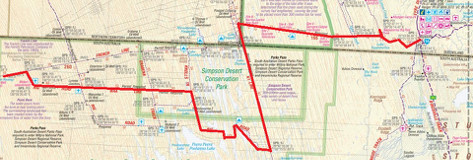
The Classic Route
Rig Road/Birdsville Track
This route follows the Rig Road for the first six stages then continues in a south easterly direction through salt lakes, the petrified forest before hitting the Birdsville Track. The route then heads north along the Old Birdsville Track into Birdsville.
The road has degraded over the years and conditions vary greatly from year to year. It is often corrugated, with stretches of deep sand and numerous washaways.
The sand dunes are encountered in the first five stages, with the track flattening out as the race reaches the salt lakes on the afternoon of Day Three.
Rain can transform the track overnight. It can be helpful by firming the sandy sections but can turn a smooth clay surface into a sticky bog that jams wheels solid with black goo in minutes.
The Classic Route is most suited to mountain bikes.
The QAA line
Rig Road/QAA Line
This route follows the Rig Road for the first six stages before turning north on the K1 Line and then east on the QAA Line. This route combines the best of the first two routes with a good mix of fast sections and big dunes including the largest dune, ‘Big Red’.

